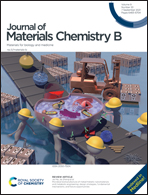Simultaneous inhibition of planktonic and biofilm bacteria by self-adapting semiconducting polymer dots†
Abstract
Biofilm infections present an enormous challenge in today's healthcare settings. Currently, pH-switchable antibacterial agents are being developed to eradicate biofilms. However, most pH-switchable antibacterial agents are less lethal to planktonic bacteria under neutral conditions, and cannot prevent the dispersed bacteria from seeding acute infection again. Herein, this work reports the applications of semiconducting polymer dots (Pdots) with a double adhesion mechanism in imaging and inhibiting bacteria inside (weak acidic conditions) and outside (neutral conditions) biofilms. Clew-like Pdots were prepared by covalently linking phenylboronic acid (PBA) and pH-responsive naphthalimide (NA) ramification in semiconducting polymers. Under neutral conditions, the Pdots combined with bacteria through the formation of boronate esters between PBA and diols. Under weakly acidic conditions, the partial borate bond fractured, and the Pdots adhered onto the bacterial surface through the positively charged NA in Pdots. Furthermore, the Pdots display negligible toxicity to mammalian cells and tissues. More importantly, the Pdots can selectively damage the bacterial membrane and inhibit bacteria in vivo. This work highlights the feasibility of using semiconducting Pdots to image and inhibit bacteria inside and outside biofilms, which represents a highly effective strategy to cope with biofilm infections.



 Please wait while we load your content...
Please wait while we load your content...